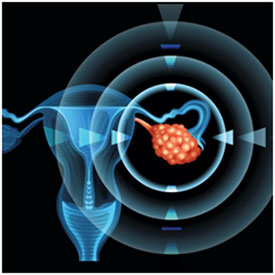

An ovarian tumor is a slow-growing abnormal mass of tissue on or in a woman’s ovary. A tumor is a solid mass, unlike a fluid-filled ovarian cyst. A tumor can be benign or cancerous (malignant), but ovarian tumors are typically benign.
Ovarian tumors most commonly occur in women of childbearing age. They occur in about 50 percent of women with irregular menstruation and in about 30 percent of women with regular menstruation.

Ovarian tumors are divided into three main types, based on where the abnormal cell growths originated:
The causes of benign ovarian tumors are not well understood. Some research suggests correlations between certain risk factors and the development of ovarian tumors:
Ovarian tumors are generally asymptomatic; meaning a woman rarely has any noticeable symptoms. In some women, the tumor is so undetectable that it eventually grows large enough to cause pelvic or abdominal discomfort by encroaching on nearby organs. In these cases symptoms may include:
Since symptoms are rare, tumors are usually spotted during routine physical exams, including a pelvic exam or Pap test. As such, women should always have routine pelvic exams to help ensure that changes in the ovaries are diagnosed as early as possible.
When ovarian tumors are present and don’t go away, when they are painful, and when they grow, they are usually treated with surgery, such as laparoscopy to remove the tumor. For larger ovarian tumors, surgeons may perform a laparotomy, and if the tumor is malignant (cancerous), the surgeon may selectively remove part or all of the abnormal growth. This process is called ovarian tumor debulking.
Some ovarian tumors are removed while leaving the rest of the ovary intact. Other times the surgeon may remove the entire affected ovary and Fallopian tube. Rarely, both ovaries are removed.
Removing one ovary will not affect the normal function of the remaining ovary. So hormone effects (pubertal change, menstruation) and reproductive capacity of the other ovary should be unaffected.
+91 81005 85462
54.BR.B. G.T. Road,
P.O. - Bhadrakali,
PS- Uttarpara,
Dist.- Hooghly,
Pin-712232